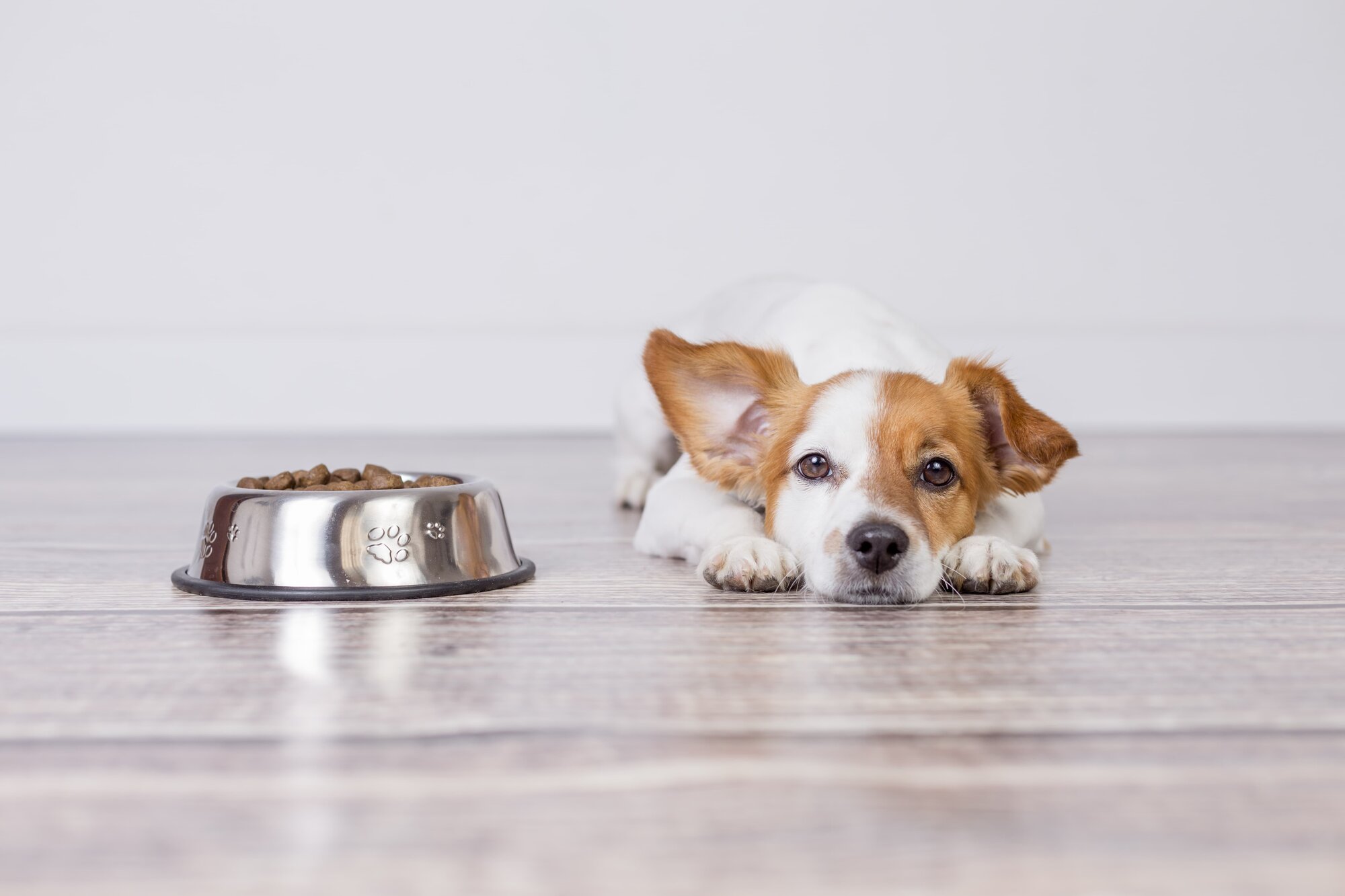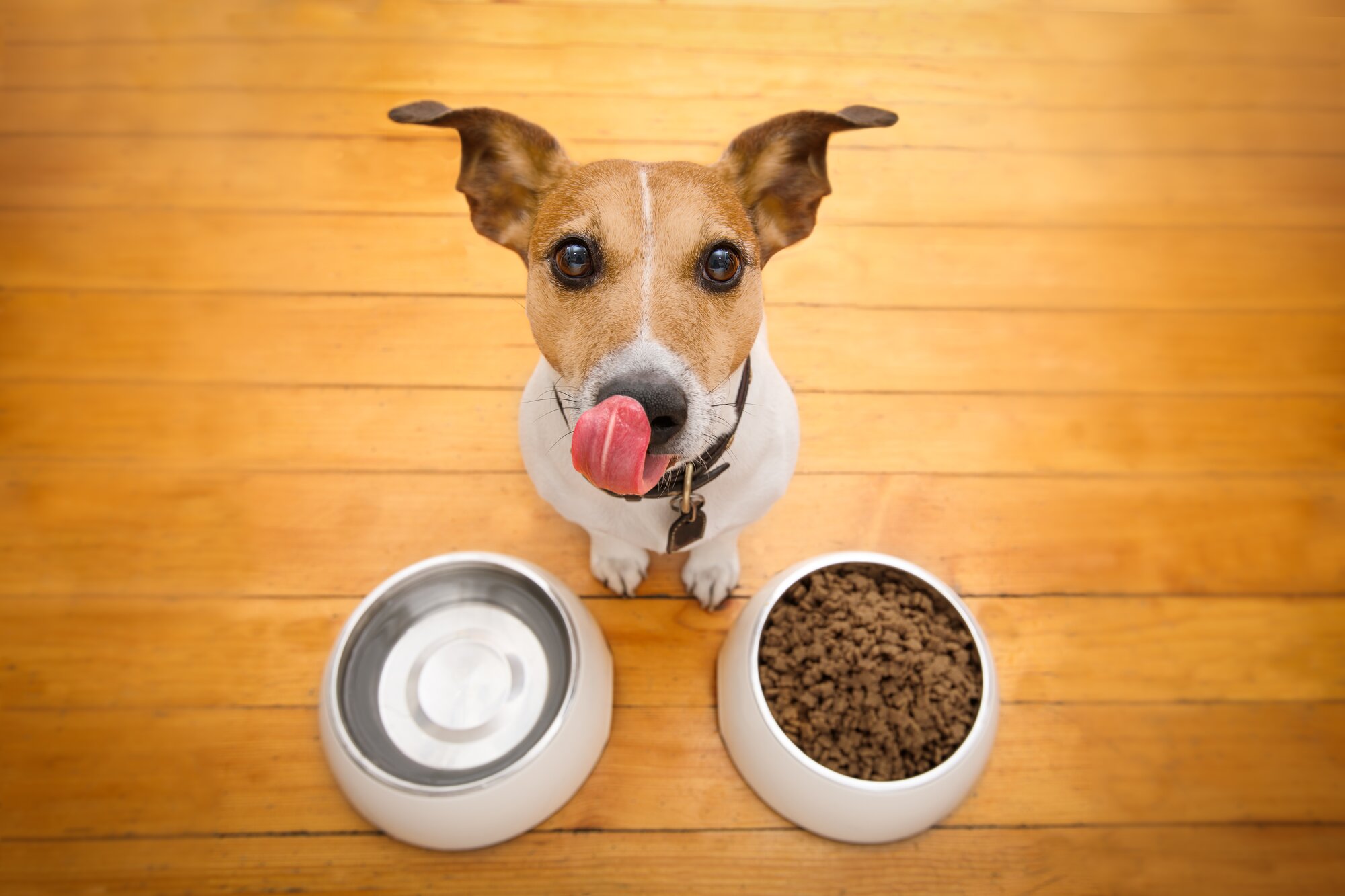Last Updated: 31/07/2025
Fussy Dog Feeding: Vet Tips
Finding it difficult to find a food that your dog won't turn their nose up at? Take a look at our top tips for managing dogs with picky appetites.
Author: Dr Katelyn Bailey BVSc (Hons)
Reading Time: 12 minutes - short read
Does the daily ritual of feeding your dog often involve a discerning sniff followed by a polite (or not-so-polite) turn of the head? Or perhaps your once-enthusiastic eater has suddenly developed a more apathetic attitude towards their meals, leaving you scratching your head in confusion?
Dealing with a fussy eater is a surprisingly common and undeniably frustrating challenge faced by many devoted pet owners. The constant worry about whether your beloved companion is getting adequate nutrition can be incredibly stressful.
In this article, we delve into the multifaceted world of canine picky eating, exploring some of the underlying reasons why your dog might be less than enthusiastic about their food. We'll share some of the Vet Squad's most effective and practical tips for navigating this perplexing issue and encouraging even the most discerning dogs to enjoy their meals.
Breeds predisposed to fussy eating
While most dogs will have food preferences, small breeds tend to be fussier eaters than larger breeds. In the Vet Squad's experience the following breeds in particular can be a little pickier with their food:
What does it mean when a dog is a fussy eater?

Pinpointing the reasons behind a dog's selective eating habits can sometimes feel like a puzzle. While each dog has their own unique preferences, certain factors frequently contribute to a dog becoming a picky eater. Some of the most commonly observed reasons include:
Underlying Medical Issues
First of all, it's important to ensure that a picky appetite is not actually a loss of appetite. A loss of appetite can occur due to illnesses that cause nausea, discomfort or pain, including but not limited to gastrointestinal, joint, cardiac, respiratory, renal and dental issues. If your dog is showing other signs along with a reduced interest in food, or if their 'fussy' behaviour is out of character, a vet check is recommended to rule out any medical causes. In most cases appetite improves when the underlying condition is treated or appropriately managed.
Signs that may indicate an underlying health issue:
- Vomiting
- Diarrhoea
- Drooling
- Lethargy/reduction in activity
- Bad breath
- Exercise intolerance
- Change in drinking habits
- Weight loss
- Frequent lip licking
- Lameness or stiffness
- Coughing
Specific personal preference
Like us, most dogs have personal preferences and may favour a certain texture, flavour and/or consistency when it comes to their food. Some dogs will take this to the extreme and refuse anything else. These dogs often eat their preferred foods with no issues but repeatedly turn their nose up at other foods.
Learned behaviour
Some dogs become fussier over time because they learn to wait for something better. Often owners inadvertently create this issue by giving in and offering their pet a higher-value treat if they don't eat their usual food. Feeding tasty 'human' food and changing diets too regularly can also contribute to this problem.
Not enough variety
While some dogs are perfectly happy to remain on the same food for life, others initially eat their food well but become bored of it after a while. These dogs will gradually show less interest in their usual food in favour of something new.
Anxiety
Anxiety is a common reason for a dog to be fussy with its food. Periods of change or adjustment, such as moving house or a new family member (two- or four-legged) can affect appetite. Lack of privacy when eating and noisy eating environments can trigger anxiety. Dogs suffering from separation anxiety can become reluctant to eat before or after their owners leave the house. These dogs may have a fluctuating, 'on and off' appetite, or suddenly go off their food when a stressor occurs.
They're not food motivated
Some dogs naturally prefer to graze on their food throughout the day rather than eat it all at once and this eating pattern can be mistaken for a picky appetite. Likewise, dogs that are attention-motivated rather than food-motivated can be misidentified as fussy eaters.
How to stop a dog from being a fussy eater

An effective management approach will depend on the underlying cause of your pet's fussy eating. You may need to play around with a few different suggestions to find the ones that work for you and your dog.
It's important to be persistent and consistent with your approach to feeding. Make sure everyone in the household is on board and decide how long to persist with a certain food- remember that offering too much variety right from the start can inadvertently train some fussy eaters to hold out for "yummier" food each time. We recommend committing to one type of diet for at least a few weeks and allowing your dog some time to adjust to it before making any further changes.
Always make sure to have a period of transition when introducing a food as this reduces the risk of gastrointestinal upset and increases the chance that the pet will accept the food.
Create a regular meal routine
Most fussy eaters will benefit from a regular, consistent meal routine. Anxious dogs, as well as dogs going through a big change such as recent adoption, absent owners or moving house, can easily be unsettled. For these pets, making mealtime as peaceful and predictable as possible is essential.
Make meal times more exciting
As already discussed, some dogs can get bored over time of the taste or texture of their usual food. Some of this boredom may also be due to the method in which they're fed. For some pets the act of eating out of a bowl becomes boring and repetitive. In the wild, dogs would forage and hunt for their food, but in domestic life it is placed in front of them and so they miss out on the challenge of finding it for themselves.
Puzzle feeders are a great idea for any dog and help make meal time more interesting. They provide engagement and enrichment that may be lacking in standard 'food in bowl' feeding rituals. You can put their normal kibble in a puzzle feeder, and lick-mats are great options for wet food.
Recommended products to make meal times interesting
Rotational diets are also a great option for pets that become bored of their food.
This feeding method involves rotating through a variety of different dog foods over time, allowing your dog to be exposed to a range of sensory experiences (taste, smell, texture). It can involve feeding different proteins, different brands or different textures (eg wet and dry foods). This helps to prevent a fussy eater from becoming sick of a certain food, while also ensuring they get a balanced diet.
For healthy adult dogs, feeding a rotational diet is perfectly fine, provided a transition period is undertaken. However for those with sensitive stomachs, or those on prescription foods, a rotational diet may not be suitable.
Make your dog's current food more palatable
Some dogs need a little time and help to learn that their food is actually tastier than they first thought! It's worth trying out some of the following tips using your dog's current food before switching to a different type.
- Most (not all) dogs respond better to wet food initially, so try to offer a wet food first- especially for young puppies that have recently been weaned
- Add warm water to wet food or gently heat wet food up in the microwave to enhance smell and taste - just make sure it's not too hot when fed
- Blend wet food to make it gravy-based then soak the kibble in this mixture
- Mix wet and dry food together (or try feeding them separately if you are currently mixing them together).
- If your pet dislikes dry food, add only a small amount of dry food to wet food at first, then gradually increase the amount of dry food over time. You can reverse this process if your dog likes dry food but not wet
- Moisten dry food with warm water to make it more palatable and easier to eat
Consider adding meal toppers
Meal toppers are formulated to be highly palatable so are a great option for fussy eaters. A small amount of the topper is mixed in with a complete and balanced dry or wet food to improve its taste and texture. It's important to note that meal toppers are not suitable as a sole diet.
If your pet is on prescription food, it is NOT recommended to add anything extra to their diet without the approval of your dog's treating veterinarian. Any additions may reduce the effectiveness of their current diet.
Recommended meal toppers for dogs
Meal toppers that can be prepared at home include:
- No-salt chicken broth
- Dog yoghurt (or plain, lactose-free yoghurt with no artificial sweeteners)
- Plain, cooked chicken (no skin)
- Plain, cooked lean meat (remove any fat)
- Plain, cooked egg
- Salmon/tuna/sardines in springwater
- Nutritional yeast
- Honey
It's recommend to keep meal toppers, as well as home-prepared food and treats, to less than 10% of your pet's daily intake to avoid nutritional imbalances.
Tips for choosing a new food

If you find that your pup is still not eating their current food after trying the above tips and persisting for several weeks, it may be time to select a new one to try. With so many different options on the market these days it can be difficult to know where to start, and the following points can help to guide your decision.
- Firstly, if your pet is on a prescription diet, discuss alternative options with your veterinarian. In most cases a similar option will be available in another brand or flavour
- If you have noticed that your dog has preferred a certain flavour or texture in the past try to find a new food with similar characteristics
- If you have not noticed a pattern with your dog's previous preferences, you could try a brand new flavour such as fish, kangaroo or turkey
- Stick to a premium brand- these tend to be more palatable and have more targeted nutrition than supermarket brands
- Some dogs may prefer a naturally preserved diet that is freeze- or air-dried. Because these foods are naturally and gently preserved they tend to retain more flavour. As an added bonus most of them are also more nutrient dense compared to standard kibble, which is a good feature for chronic fussy eaters.
For further guidance or specific food suggestions for your fussy eater, feel free to contact our Vet Squad via live chat, Vet Pet Plan or email.
Dealing with a dog who turns up their nose at dinner can indeed be a frustrating journey for any pet owner. However, by understanding the potential underlying causes, from medical issues and learned behaviours to simple preferences and the need for a more engaging mealtime, you can begin to implement effective strategies.
Remember that patience and consistency are key, and consulting with your veterinarian is the crucial first step to rule out any health concerns and to receive tailored advice. By creating a predictable and positive eating environment, exploring different textures and flavours, and perhaps introducing the excitement of puzzle feeders or a rotational diet, you can often encourage even the most discerning canine palate.
While it may take some experimentation, the goal is to find a nutritious and palatable food, coupled with a feeding routine, that your pooch enjoys, ensuring they receive the vital nutrients they need to thrive.
Don't hesitate to reach out to the Vet Squad for further personalised guidance on navigating your dog's individual preferences and ensuring a happy and healthy mealtime for both of you.
Further Reading
Want to read more? Check out our other articles:
History
Our experts continually monitor the health and wellness space and we update our articles when new information becomes available.
Wed Feb 1 2023
Written by Dr Katelyn Bailey BVSc (Hons)Dr Katelyn Bailey BVSc (Hons)
Veterinarian
Dr Katelyn Bailey graduated as a veterinarian from The University of Queensland in 2018 and has since worked in small animal general practice clinics in south-east Queensland. Her special interests include feline medicine and behaviour, preventative health care, internal medicine, research and senior pet care. Katelyn is a strong proponent of the human-animal bond and loves to hear about the quirks that make each pet so special.

